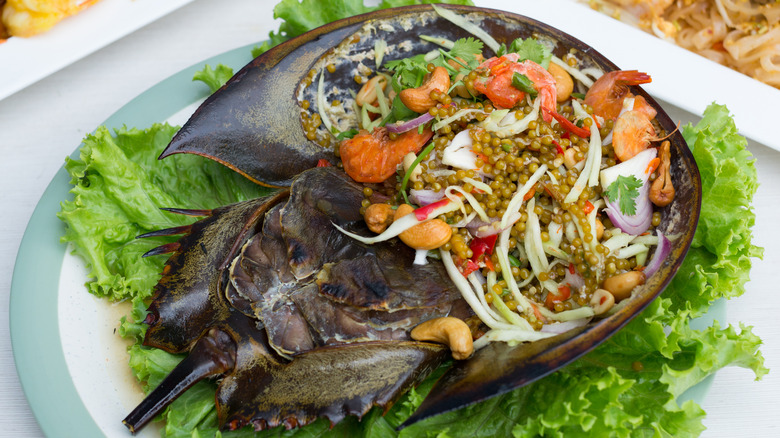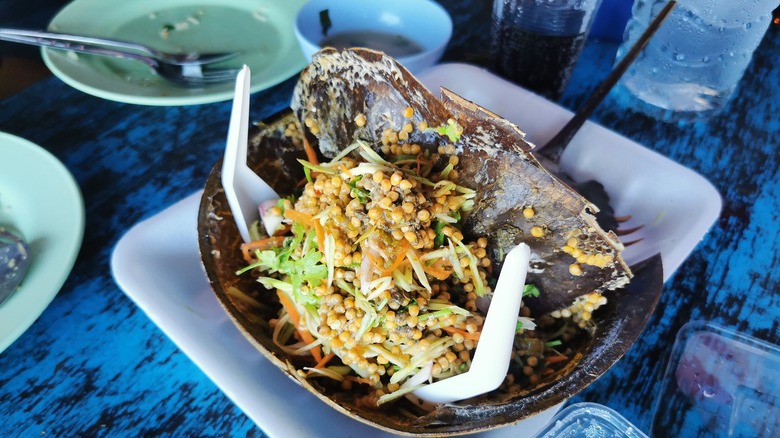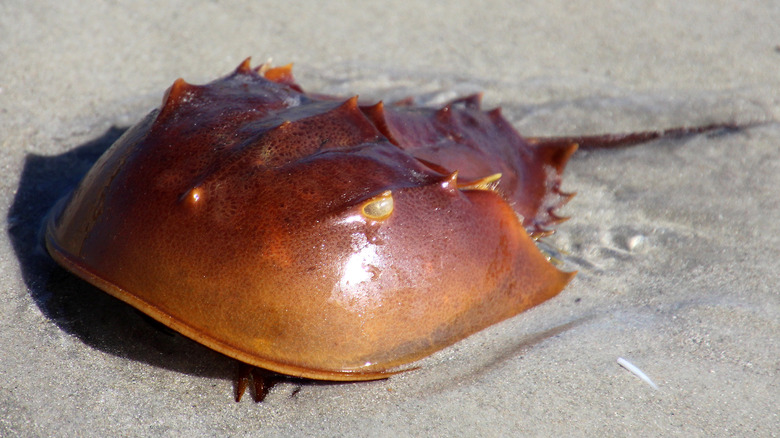If You Ever Come Across A Horseshoe Crab, Here's How To Eat It
Stumbling upon a horseshoe crab while in the ocean can be a bit jarring if you're unfamiliar with the animals; they aren't exactly cute. But these prehistoric-and-modern creatures have been around for 445 million years — since before dinosaurs roamed the Earth. Just like plenty of other sea creatures, horseshoe crabs are edible, but you won't find the same level of meat you'd get in a snow crab or king crab. Rather, the main delicacy is the eggs, known as roe.
Horseshoe crab meat can be consumed, as well, but with little meat inside the crab, it's not usually eaten on its own. The meat and eggs are commonly enjoyed together in certain parts of Asia, including Japan and Taiwan. However, one species is toxic and two others are either endangered or vulnerable (close to becoming endangered), so there is plenty to know before you try to catch and eat them at your leisure.
Eat horseshoe crab eggs and meat
Horseshoe crabs are commonly found in Asia, with three of the four species living there. (One species, Limulus polyphemus, is commonly seen along the United States' east coast.) Horseshoe crabs are mostly harvested for their eggs, but it's not as simple as plucking one from the ocean and eating its raw eggs. Rather, you have to either steam or grill the horseshoe crab first before consuming the eggs inside.
Horseshoe crab eggs range in color, and they're said to have a rubbery texture. The meat from horseshoe crab claws is also edible, though the claws are tiny, so you probably shouldn't go through the effort of capturing and cooking a crab unless you plan to eat its eggs, as well.
To prepare the crab, rinse it then use a basic cooking method like grilling or steaming to cook the meat and eggs. In Thailand, one method used is to grill the crabs over an open flame on both sides. The shells are then cut open, which exposes the eggs. From there, you can eat the meat and eggs, which are usually garnished with pickled daikon or peanuts. Another method is to cook the crabs in boiling water, then finish them on the grill.
Some horseshoe crabs are endangered, others poisonous
There are two important things to consider before you decide to go horseshoe-crab hunting. First, some species are at risk of eventually going extinct; second, one variety of the crab is highly poisonous.
Before you try to capture and cook horseshoe crabs yourself, it's important to understand the rules surrounding their consumption. In the United States, the American horseshoe crab is listed as "vulnerable to extinction," according to the International Union for Conservation of Nature. In certain places, such as Florida, killing horseshoe crabs is illegal. The tri-spine horseshoe crab, which is found in Asia, is endangered, though it's still consumed in many places.
Additionally, one horseshoe crab species contains deadly toxins. In Thailand, the mangrove horseshoe crab is poisonous to humans and should never be consumed, as reported by the Phuket News. (Indo-Pacific horseshoe crabs found in the region, though, are safe to eat.) Horseshoe crab poisonings are reported often in Thailand; in 2023, a pair of individuals died and a handful more were sent to the hospital after consuming mangrove horseshoe crabs.


